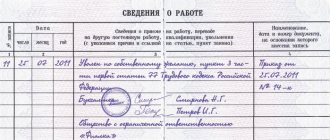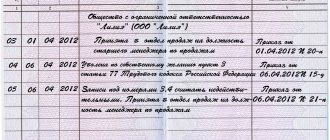How to arrange the transfer of employees to a separate unit in another city?
That is, the employee performs the same work when changing jobs.
In this case, there is no need to obtain consent to move the employee himself. When transferring, the terms of the employment contract and the employee’s job function change. An employee is considered transferred to a new position in the same organization (without changing location) if at least one of the conditions is met:
- change in the labor function provided for in the employment contract.
AttentionAt the same time, the place of work may change or remain the same;
- change in the structural unit in which the employee works. In the case where the structural unit as the place of work was indicated in the employment contract with the employee.
Transfer is permitted only with the written consent of the employee.
NOT FORGET! Make an entry in the employee’s work book about transfer to another permanent job. Before starting work, the employee should be given initial training at the new workplace. Training is usually carried out by an occupational safety specialist or an employee assigned these responsibilities.
Thus, the transfer of employees from one branch to another is carried out according to the general rules provided for the transfer of an employee from one structural unit to another. At the same time, the peculiarities of documenting such a transfer directly depend on the form of organization of personnel records established in the company.
https://youtu.be/SuWc9qjmVNg
Transfer of an employee from one branch to another
If an employee is transferred from one branch to another, located in a different area, then the registration takes place according to the same rules that are established for transfers within the same organization.
Important! If an employee moves from one branch to another and his position is retained, then the registration is registered as a transfer.
An entry about the transfer of an employee is made in the work book no later than 1 week from the date of transfer. After this, the entry is made in the employee’s personal card, in which the latter is introduced to the employee’s signature.
Difference in Concepts
Transfer of an employee is a movement together with an enterprise to another region or a change in the type of activity of the employee or the structural unit in which he works, while the place of work remains the same production.
Relocation is not a reason for changing the duties and functions of a specialist, and therefore his consent is not provided.
Such movement within the organization does not entail adjustments to the clauses of the contract; the employee continues to perform his duties in accordance with the agreements. In such a case, there is no need to complete documentation or issue orders.
Transfer of an employee, relocation of an employee
* Labor relations * Hiring Transfer – Transfer part 2 – Transfer part 3 Dismissal * Part-time and part-time work
Difficulties in transferring an employee
In personnel practice, quite often there is a need to transfer an employee.
The reasons for the transfer may also be production needs, leading to changes in the staffing table; expansion of the organization’s activities or, conversely, reduction; solving problems of professional and career growth of personnel; certification results that led to the promotion or demotion of an employee, etc.
Transfer to another job is associated with a change in the essential terms of the employment contract. Such conditions are: • place of work; • labor function; • amount of remuneration; • working hours; • benefits and other circumstances provided for by law, both directly agreed upon when concluding an employment contract and derivative ones.
A transfer involves performing a different job than that specified in the employment contract. The translation changes the content of the contract and therefore, in accordance with the Labor Code of the Russian Federation, is permitted only with the written consent of the employee. The Labor Code does not contain an exhaustive list of the essential terms of the contract.
They are determined on a case-by-case basis. If material conditions change without specifying a time frame, then such changes will be regarded as permanent. If they are limited to the period specified in the order, they will be classified as a temporary transfer.
Promotion and demotion are also transfers requiring the employee's consent.
Relocation or translation?
Part 3 of Article 72 of the Labor Code of the Russian Federation states that “relocating him in the same organization to another workplace, to another structural unit of this organization, or assigning work on another mechanism or unit is not a transfer to another permanent job and does not require the consent of the employee, if this does not entail a change in the labor function or a change in the essential terms of the employment contract.” This means that the employee moves to another structural unit, but his position, job responsibilities, salary (tariff rate) and other essential terms of the employment contract do not change. The problem arises due to the fact that in Article 57 of the Labor Code of the Russian Federation “employment contract”, among the essential conditions of the employment contract, the place of work comes first, and in the case when an employee is hired to work in a branch, representative office or other separate structural unit of the organization located in another area, indicating the structural unit and its location. The structural unit is an essential condition of the employment contract. A change in a structural unit is considered a move only if, when concluding an employment contract, it (the structural unit) was not specified, and the employment contract did not provide for the condition of working in this particular structural unit. If, when concluding an employment contract, a structural unit was specified, then a change in a structural unit is considered a transfer and for its implementation it is necessary to first obtain the written consent of the employee. In practice, there are cases when movements after some time can actually be perceived as a transfer. For example, an employee was transferred to another structural unit without changing his job function, but in the process of working in the new structural unit it turns out that there are certain specifics that automatically lead to an expansion of the range of job responsibilities, an increase in the volume of work, etc. The transferred employee begins to be indignant, demand changes to the employment contract and, as a result, increase wages - a conflict situation arises. Since it is sometimes quite difficult to calculate the change in the labor function at the stage of moving an employee from one structural unit to another, it is better for a personnel specialist to play it safe in order to avoid a conflict situation in the future. The procedure for registering the movement of an employee is the same as for a transfer. If the employment contract indicates the name of the structural unit in which the employee was hired, changes should be made to it.
For example: When concluding an employment contract with a manager, the contract indicated that he was hired at Teremok LLC in the advertising department. In this regard, after a certain time, the personnel inspector had to formalize his transfer (with prior written consent) to the administration, despite the fact that neither his job function, nor the title of the position, nor the salary had changed. And if the employment contract had not specified “advertising department” as the place of work, this would have been a relocation, which would have caused much less hassle.
Constant transfers
The following four types of employees are possible: • transfer within the same organization at the initiative of both the employer and the employee; • transfer to another organization for permanent work; • transfer to another location together with the organization; • transfer of an employee with his consent based on a medical report.
The types of permanent transfers specified in the Labor Code differ not only in their reasons, but also in the legal consequences of the employee’s refusal to transfer: if he refuses a transfer offered by the employer within the same organization, the employee remains at his previous job, and if he refuses in the other three cases, he is fired, but for three different reasons.
If the employee’s written consent to the transfer was not received, but he voluntarily began performing other work, such a transfer can be considered legal (clause 12 of the resolution of the Plenum of the Supreme Court of the Russian Federation of December 22, 1992 No. 16).
Article 74 of the Labor Code of the Russian Federation regulates changes in the essential terms of an employment contract for reasons related to changes in organizational or technological working conditions. At the same time, it is allowed to change the essential terms of the employment contract determined by the parties at the initiative of the employer while continuing work without changing the labor function.
Article 74 of the Labor Code of the Russian Federation actually legalizes this type of transfer, which does not entail a change in the labor function, and all other terms of the contract, including salary, work and rest hours, etc., can change without the consent of the employee.
In such cases, the employee is provided with certain guarantees: the employee must be notified in writing by the employer of the introduction of these changes no later than two months before the innovations;
if the employee does not agree to continue working under the new conditions, the employer is obliged in writing to offer him another job available in the organization that corresponds to his qualifications and state of health, and in the absence of such work, a vacant lower-paid position or lower-paid work that the employee can perform taking into account his qualifications and health status. In addition, if a change in organizational
or technological working conditions may lead to mass layoffs of workers, the employer, in order to preserve jobs, has the right, taking into account the opinion of the organization’s trade union body, to introduce
part-time work for a period of up to six months
. And finally, an important guarantee is that changes to the essential terms of the employment contract, introduced in accordance with Article 74 of the Labor Code of the Russian Federation, cannot worsen the position of the employee in comparison with the terms of the collective agreement and agreement.
If the previous essential working conditions cannot be maintained, and the employee does not agree to continue working under the new conditions, the employer is obliged to offer him in writing another job available to him that corresponds to the qualifications and state of health of the employee.
In the absence of such work, the employee is offered a vacant lower-level position or a lower-paid job, taking into account the qualifications and health status of the employee.
If the proposed work does not suit the employee or the employer does not have such work, the employment contract is terminated in accordance with paragraph 7 of Article 77 of the Labor Code of the Russian Federation.
Termination of an employment contract on this basis is possible only in the event of a real significant change in working conditions in the organization, which requires the employer to pay careful attention to such situations.
For example: The secretary of Parus LLC was fired due to her refusal to perform the functions of a personnel inspector. She went to court and was reinstated to her previous job.
When comparing the old and new instructions, the court found that the secretary was not assigned additional duties. The organization retained the personnel department, and the mere fact of a reduction in the number of employees in this department is not enough to conclude that it is necessary to change the working conditions of the secretary to include the duties of a personnel inspector in his functions. The most common situation is a transfer within the same organization. An employer can transfer an employee to work in another profession, specialty, position, qualification, as well as to work in another location, for example, to a branch located in another city.
As a rule, the transfer of an employee is allowed only with his consent
(Articles 72 - 74 of the Labor Code of the Russian Federation),
the transfer can be permanent or temporary .
It is not allowed to transfer an employee to a job that is contraindicated for him due to health reasons. According to the requirements of Article 74 of the Labor Code of the Russian Federation, the employee must be notified in writing about the proposed transfer at least two months in advance. If an agreement is reached with the employee on the transfer, there is no need to postpone changing the terms of the employment contract for 2 months. According to the terms of Article 72 of the Labor Code of the Russian Federation, if the parties agree, changes to the employment contract regarding transfer to a new job come into force on the agreed date. If the employee does not agree with the new conditions, the company is first obliged to offer him another job that corresponds to his qualifications and taking into account his state of health. If there is no such job, then management must offer a vacant lower-level or lower-paid position. If this is also impossible or the employee himself refuses such work, then the organization can dismiss him on the basis of paragraph 7 of Article 77 of the Labor Code of the Russian Federation.
Transfer to another job in accordance with a medical report
In some cases, the employer is obliged to transfer the employee to another, easier job with his written consent and in accordance with a medical report issued in the manner established by federal laws and other regulations of the Russian Federation.
The transfer should be carried out for employees who need light work due to health reasons; pregnant women and women with children under the age of one and a half years; workers who were injured or otherwise damaged at work. In these cases, the transfer order is issued on the basis of the employee’s application and the corresponding medical report.
When an employee is transferred to an easier, lower-paid job due to health reasons, he retains his previous average earnings for one month
from the date of transfer.
If the transfer is related to an injury or occupational disease, then the average salary is retained longer - until the employee recovers or doctors establish his disability (Article 182 of the Labor Code of the Russian Federation).
If an employee who, in accordance with a medical report, needs a temporary transfer to another job for a period of up to 4 months, refuses the transfer
or the employer does not have the appropriate job, the employer is obliged to suspend the employee from work for the entire period specified in the medical report while maintaining his place of work (position).
During the period of suspension from work, wages are not accrued to the employee, except in cases provided for by the Labor Code, other federal laws, collective agreements, agreements or employment contracts.
If, in accordance with a medical report, an employee needs a temporary transfer to another job for a period of more than 4 months or a permanent transfer, then if he refuses the transfer or is absent from the employer
for the corresponding work, the employment contract is terminated in accordance with paragraph 8 of Article 77 of the Labor Code of the Russian Federation.
In accordance with Article 169 of the Labor Code of the Russian Federation, when transferring to another location, the organization is obliged to reimburse the employee for moving expenses. Travel expenses for the employee and his family members, as well as expenses for transporting property to a new place of work are reimbursed. In addition, the employee is paid daily allowance and salary for each day of travel. Salaries are also paid for the days during which he was getting ready to travel and settling in a new place of residence. The organization has the right to establish other compensation standards - in larger amounts.
If an employee refuses to move to another area, then he can be fired (clause 9, Article 77 of the Labor Code of the Russian Federation) with the payment of severance pay equal to his two-week average earnings (Article 178 of the Labor Code of the Russian Federation).
When is transfer possible?
During the transfer process, the employee’s functions change, as does the workplace, so it must be properly formalized:
- notify the employee or obtain a statement from him. Here you will learn how to submit an application for transfer to another position;
- obtain his consent;
- sign an additional agreement to the employment contract. You can read how to correctly draw up an additional agreement and what needs to be included in it here;
- issue an order;
- make an entry in the work book, personal file and other personal documents of the employee.
First of all, the employer must interest the employee in the new position and negotiate with him.
After a positive outcome of the conversation, a free-form notification is generated, on which the employee must leave his written consent to the transfer. In addition, the employee can write an application for transfer, which will also be regarded as his consent.
Important: the moment of obtaining the employee’s consent is very important, since it must be obtained before the transfer order is issued.
Entry in the work book about the transfer.
After this, an order is issued and the employment contract is adjusted with a separate annex to it. All documents must be signed by the employee.
When making an entry into the labor record, you should remember that the main employer, even if transferred to a separate division, remains the main enterprise. In the process of filling out the book, you must follow clause 3.1 of the Instructions for filling out approved books. Resolution of the Ministry of Labor No. 69 of 2003.
| Antares LLC | |||||
| 12 | 13 | 10 | 2018 | Dismissed by agreement of the parties on the basis of Part 1 of Art. 77 Labor Code of the Russian Federation | Order No. 23k dated October 13, 2018 |
| 13 | 14 | 10 | 2018 | Hired as head of a separate division | Order No. 24k dated October 14, 2018 |
In this case, another locality is understood as an area outside the administrative-territorial boundaries of the corresponding locality (clause 16 of the resolution of the Plenum of the Supreme Court of the Russian Federation dated March 17, 2004 No. 2). This conclusion follows from the provisions of parts 1 and 3 of Article 72.1 of the Labor Code of the Russian Federation.
Thus, the transfer of an employee from one branch to another, which is located in a different area, while maintaining the position, regardless of whether the branch was indicated in the employee’s employment contract or not, must be formalized as a permanent transfer within the same organization. For the procedure for documenting such a translation, see
What documents need to be completed when transferring an employee within the same organization. Attention: the transfer of an employee between branches located in the same area, if the branch was not indicated in the employment contract, while maintaining the position, is formalized according to the rules of transfer.
Let us remind you that separate divisions are not independent legal entities, and an employee, when transferred from branch to branch, continues to work for the same employer. Therefore, it would be illegal to dismiss an employee in this case, since there are no grounds for terminating the employment contract.
We are talking about a transfer to another job with the same employer (to another unit for the same position or to another), which is carried out with certain features determined by the territorial isolation of the units.
Stage 3 Drawing up an additional agreement to the employee’s employment contract. Next, the parent organization draws up an additional agreement to the employee’s employment contract, which reflects all the new conditions associated with work in another separate structural unit (example 7).
conclude an additional agreement to the employment contract, issue a transfer order and make entries in the work book and personal card. Details in the materials of the Personnel System: 1. Answer: How to formalize the transfer of an employee to a permanent job within one organization Types of transfers What types of transfers are provided for in the Labor Code of the Russian Federation The Labor Code of the Russian Federation provides for two types of transfers to another job: temporary and permanent (Art.
about the author
And we also have
Place of work in the employment contract.
Speaking about structural units, it is necessary to decide on such a condition of the employment contract as the place of work. In accordance with Art. 57 of the Labor Code of the Russian Federation, the employment contract must indicate the place of work, and in the case when an employee is hired to work in a branch, representative office or other separate structural unit of the organization located in another area, the place of work indicating the separate unit and its location.
It is not specified what is meant by the term “place of work.” Therefore, some indicate the name of the organization, some indicate a city or other locality, and some indicate the exact address.
The Presidium of the Armed Forces of the Russian Federation in the Review of the practice of consideration by courts of cases related to the implementation of labor activities by citizens in the regions of the Far North and equivalent areas (approved on February 26, 2014), in this regard, explained that in the theory of labor law, a place of work is understood as located in a certain locality (settlement) a specific organization, its representative office, branch, other separate structural unit. If the organization and its separate structural unit are located in different areas, based on Part 2 of Art. 57 of the Labor Code of the Russian Federation, the employee’s place of work is specified in relation to this unit.
If we turn to clause 2 of Art. 54 of the Civil Code of the Russian Federation - the location of a legal entity is determined by the place of its state registration on the territory of the Russian Federation by indicating the name of the locality (municipal entity).
And based on the Letter of the Ministry of Labor of the Russian Federation dated November 17, 2017 No. 14-2/B-1012, as a condition on the place of work, the name of the employing organization is prescribed in the employment contract, containing an indication of the organizational and legal form.
We can conclude that it is necessary to include in the employment contract the address where the employees are located not in the condition of the place of work, but in the condition of the workplace, since the workplace is the place where the employee must be or where he needs to arrive in connection with his work and which is directly or indirectly under the control of the employer (Part 6 of Article 209 of the Labor Code of the Russian Federation). Since the workplace is an additional condition of the employment contract, it may or may not be included in it.
As a place of work, the employment contract should indicate the name of the employer and an indication of its location (location in a specific locality). For example: “The Employee’s place of work is the State Budgetary Healthcare Institution “Central District Hospital No. 1” (GBUZ CRH No. 1), Kstovo, Nizhny Novgorod Region.”
Separate division: registration in the labor register
Info
Mixed" office work - involves both centralized processing of personnel documents (for example, registration of employment, termination of an employment contract), and decentralized (for example, imposition of disciplinary sanctions on employees, storage of personal files). The division is usually made according to various personnel functions - part belongs to the parent organization, part is transferred to a separate unit.
OUR ADVICE Specify in a local regulatory act, for example in the Instructions for Personnel Records Management, the procedure for preparing personnel documents when transferring an employee from one separate division to another, as well as the procedure for transferring for further maintenance and storage of personnel documents, the procedure for transferring work books, etc.
How to place an order
There are no rules for the execution of the order or its content, so it can be written on a simple blank sheet of A4 or even A5 format or company letterhead, either by hand or in printed form. At the same time, a printed version on letterhead will be much more advantageous, since it initially contains the details of the organization, legible text, and looks more solid.
The order is issued in a single copy , but if necessary, an unlimited number of copies can be made.
Creation of a separate division
If the transfer is initiated by an employee, then he draws up a transfer application. If the transfer of an employee is initiated by the employer, then it is necessary to notify the employee about the transfer and obtain his consent to these changes in work.
The employer can draw up a notice of transfer in free form. The employee must read the notice and, having confirmed his consent, sign “I agree to the transfer” directly on the notice.
In particular, information about hiring, transfers to another permanent or temporary job, and dismissal is entered into the employee’s work book and personal card. There are no instructions in the legislation regarding whether an entry is made in the work book about moving to a separate unit.
The relocation of an employee must be formalized by order of the employer.
Return back to Employee Transfer Let's figure out what exactly is meant by transfer to a separate unit. The entry in the work book will depend on whether the employee’s place of work changes.
Employers often confuse the concepts of transfer and relocation of workers, but these concepts have significant differences. To ensure that the documents are completed correctly, it is necessary to determine whether the employee is being moved or transferred.
In both cases, the employee remains to work for the company. However, when moving, the terms of the employment contract remain unchanged, including the employee’s work responsibilities do not change, and the location where work duties are performed does not change.
The employer does not need to obtain his consent to formalize the relocation of an employee. When an employee is transferred, the employee's job responsibilities or the area in which the employee performs his or her work may change.
Types and execution of transfers within the organization – All about personnel
There is an expression “no one is irreplaceable” - and it perfectly confirms the meaning of replacing one employee with another.
After all, it happens that an employee, for example, is on sick leave for a long time, and his absence at one time or another negatively affects the work of the entire organization. In such cases, the employer may assign the duties of the absentee to another employee.
In this article we will help the employer understand what a transfer is, what types of transfers there are, for how long they are carried out and how to process them.
The concept of translation is given in Art. 72.1 of the Labor Code of the Russian Federation, according to which this is a permanent or temporary change in the labor function of the employee and (or) the structural unit in which he works (if the unit was specified in the employment contract), while continuing to work for the same employer, as well as transfer to work in another locality together with the employer.
Let us remind you that:
- labor function - work according to the position in accordance with the staffing table, profession, specialty indicating qualifications; the specific type of work entrusted to the employee (Article 15 of the Labor Code of the Russian Federation).
Labor functions are determined by the employer on the basis of unified tariff and qualification reference books for jobs, professions and positions.
The list of job responsibilities is reflected in the employment contract or job description;
— a structural unit is a separate structural unit (representative offices, branches) or non-separate, formed as a result of the internal structuring of the organization’s staff (administrations, divisions, departments, departments, services, etc.);
- another area is an area outside the administrative-territorial boundaries of the corresponding locality.
In turn, a populated area is a populated place within one built-up plot of land - a city, town, or urban-type settlement (clause 16 of the Resolution of the Plenum of the Armed Forces of the Russian Federation dated March 17.
2004 N 2 “On the application by the courts of the Russian Federation of the Labor Code of the Russian Federation”).
What kind of translations are there? First of all, transfers can be divided into temporary and permanent. In turn, temporary transfers can be divided into those carried out with the consent of the employee and transfers without consent. And a separate group can be divided into translations that are carried out without fail.
Let's figure it out in order.
Temporary transfers
So, temporary transfers can be carried out by agreement between the employee and the employer or at the initiative of the employer without the consent of the employee.
A temporary transfer with the consent of the employee, as a rule, is made to a vacant position before a permanent employee is found for it, or for the duration of replacing a temporarily absent employee, whose job is retained in accordance with the law.
The period of temporary transfer by agreement of the parties cannot be more than a year, and when such a transfer is carried out to replace a temporarily absent employee, a period is set until this employee returns to work (Part 1 of Article 72.2 of the Labor Code of the Russian Federation).
A temporary transfer is formalized by an agreement concluded in writing, which, in addition to the position to which the employee is transferred, indicates the period of such transfer. If the deadline is not known, write “until the temporarily absent employee leaves.”
Based on the agreement, a temporary transfer order is issued.
Please note that if, at the end of the transfer period, the employee’s previous job is not provided, and he did not demand its provision and continues to work, then the condition of the agreement on the temporary nature of the transfer loses force and the transfer is considered permanent (Article 72.
2 Labor Code of the Russian Federation). Therefore, if the employer misses the deadline, he risks having to find a new job for the temporarily absent employee. Therefore, we recommend reminding the employee that the temporary transfer period is ending by sending a notice.
And if the period of temporary transfer was not specified in the agreement, then you can either formalize the provision of the previous job by concluding a new agreement, or send a notice on the day the permanent employee leaves. In addition, an order should be issued to end the period of temporary transfer and provide the temporary employee with his previous place of work, which should be familiarized to the employee against signature.
Note!
An entry about a temporary transfer is not made in the work book.
In contrast to a temporary transfer by agreement of the parties, an employer can transfer an employee without his consent only in certain cases established by Part 3 of Art. 72.2 Labor Code of the Russian Federation:
- disasters of a natural or man-made nature, industrial accidents, industrial accidents, fire, flood, famine, earthquake, epidemics or epizootics and any exceptional cases that threaten the life or normal living conditions of the entire population or part of it (Part 2);
— downtime (temporary suspension of work for reasons of economic, technological, technical or organizational nature);
— the need to prevent destruction or damage to property;
— the need to replace a temporarily absent employee (Part 3).
Downtime, the need to prevent destruction or damage to property, or the replacement of a temporarily absent employee must be caused by emergency circumstances specified in Part 2 of Art. 72.2 Labor Code of the Russian Federation. Emergency situations include any circumstances that threaten the life or normal living conditions of the population or part of it.
A transfer without the employee’s consent is formalized by an order from the employer indicating the circumstances that led to such a transfer. If an employee is transferred to a position requiring lower qualifications, written consent should be sought from him. Payment in this case is made in an amount not lower than the average earnings for the previous job.
Note!
The period of temporary transfer at the initiative of the employer cannot exceed one month.
The employer can also temporarily transfer an employee, with his consent, for the duration of the suspension of work in connection with an administrative suspension of activities or a temporary ban on activities in accordance with the legislation of the Russian Federation due to a violation of state regulatory labor protection requirements through no fault of the employee. At the same time, he retains his place of work (position) and average earnings (Article 220 of the Labor Code of the Russian Federation).
One type of temporary transfer with the consent of the employee is the transfer of an athlete to another employer. The translation procedure is established by Art. 348.4 Labor Code of the Russian Federation. Such a transfer is carried out in cases where the employer is not able to ensure the athlete’s participation in competitions.
The transfer of an athlete to another employer is temporary and cannot last more than one year. A temporary transfer is made by agreement between the two employers and the athlete, on the basis of which an order for a temporary transfer is issued. In this case, a fixed-term employment contract is concluded with the temporary employer. An appropriate order is issued.
During the transfer, employment relations with the first employer are suspended.
Constant transfers
Often, an employee, having worked in one organization for a sufficient amount of time, wants to move to another position or to another department, or the employer himself wants to transfer him, for example, to promote him. In this case, a permanent transfer is carried out. It is possible both at the initiative of the employee and at the initiative of the employer.
What distinguishes a permanent transfer from a temporary one is that it cannot be made without the consent of the employee, that is, if the initiator of the transfer is the employer, he must first request the employee’s consent in writing.
If the employee does not object to the transfer, he expresses his consent either at the employer’s proposal or in a separate document (application).
Then the employee and employer enter into an additional agreement to the employment contract, which specifies the name of the new position, the amount of remuneration and other conditions that have changed due to the transfer. The agreement is drawn up in two copies for each party; on the employer’s copy, the employee marks the receipt of his own.
Note!
Separately, we note that if an employee is transferred to a position for which a fixed-term relationship is provided (for example, to the position of a manager), it is better not to enter into an agreement, since reclassification of an open-ended employment contract into a fixed-term one can be regarded as an infringement of the employee’s rights.
In this case, it is better to terminate the previously concluded employment contract and enter into a new fixed-term one. Based on the agreement, the employer issues an order to transfer the employee to another position or to another unit. The order can be drawn up in the unified form T-5, approved by Resolution of the State Statistics Committee of the Russian Federation dated January 5, 2004 N 1, or in any form.
Source: https://info-personal.ru/upravlenye-personalom/vidy-i-oformlenie-perevodov-vnutri-organizacii/
Transfer of an employee when the workplace is specified
If the employment contract contains a clause regarding a structural unit as a workplace, then the company has the right to transfer an employee to another structural unit only with his written consent.
The employer has the right to change this condition unilaterally only if, for reasons related to changes in organizational or technological working conditions (changes in equipment and production technology, structural reorganization of production, other reasons), it cannot be maintained (Part 1 of Art. 74 Labor Code of the Russian Federation).
For example, an employer transfers an employee to another structural unit due to the cessation of activities at the location of the unit (for example, the closure of a branch). Such a transfer of an employee, according to the author, can be recognized as due to a change in organizational working conditions.
Let us note that the list of reasons associated with changes in organizational or technological working conditions is open and is of an evaluative nature (Article 74 of the Labor Code of the Russian Federation). An analysis of judicial practice allows us to conclude that the list contains circumstances that lead to such significant changes in the organization of labor of workers or the technology of the production process itself that the previously determined terms of the employment contract by the parties can no longer be objectively preserved (appeal determinations of the Investigative Committee for civil cases of Zabaikalsky Regional Court dated July 10, 2012 in case No. 33-2165-2012, IC for Civil Cases of the Kirov Regional Court dated August 21, 2012 in case No. 33-2511).
The company is obliged to notify in writing (see sample) no later than two months in advance the employee whose employment contract specifies a specific structural unit as the place of work, about upcoming changes to the terms of the employment contract determined by the parties, as well as about the reasons that necessitate such changes (Part 2 of Article 74 of the Labor Code of the Russian Federation).
If, when organizational or technological working conditions in a company change, a person does not agree to work in the new conditions, the company is obliged to offer him in writing all of its available vacancies in the area, to which he can transfer, taking into account his qualifications and state of health. In the absence of such vacancies or refusal of them, the employment contract with the employee is terminated (Parts 3, 4, Article 74, Clause 7, Part 1, Article 77 of the Labor Code of the Russian Federation).
Thus, if the employment contract does not indicate a specific workplace (for example, the address of a branch), then the transfer of an employee to another structural unit located within the boundaries of the same locality does not require consent.
If the employment contract specifies a specific workplace, then the company has the right to unilaterally change this condition of the employment contract only if it is impossible to maintain it due to changes in organizational or technological working conditions. At the same time, no later than two months in advance, the company is obliged to notify the employee in writing about the upcoming change in the terms of the employment contract for the workplace, as well as the reasons that caused it (appeal ruling of the Investigative Committee for civil cases of the St. Petersburg City Court dated January 19, 2015 in the case No. 33-404/2015; ruling of the Leningrad Regional Court dated January 30, 2013 No. 33-43/2013).
print version
Degtyareva A.G. (02/05/2018 at 16:10:48)
Good afternoon
How to prepare personnel documents when opening a separate division?
That is, a division is territorially separate from the parent organization if it is located in the territory where tax accounting and tax control is carried out by a tax authority other than the one with which the organization is registered as a taxpayer. As we understand, tax accounting and control in the city.
Surgute is carried out by another tax authority, and therefore there is such a feature as territorial isolation. Job creation is the second criterion for recognizing a unit as separate. At the same time, a workplace is understood as a place where an employee must be in connection with his work and which is directly or indirectly under the control of the employer (Part.
6 tbsp. 209 of the Labor Code of the Russian Federation). Therefore, when considering disputes about the presence (absence) of a separate division, arbitration courts, first of all, pay attention to this point.
How to properly process the transfer of an employee from a separate unit to the main enterprise?
Answer to the question: If as a transfer, then who should issue the order for the transfer?
Transfer documents must be prepared by employees of the HR department of the head office and signed by the director of the organization, not the branch.
Consequently, a record of the transfer must also be made at the head office. This conclusion is based on the following: The General Director is a representative of a legal entity. At the same time, the general director acts on the basis of the Charter, and has the right, on the basis of a power of attorney, to delegate his powers to regulate personnel issues to the director of the branch.
The powers of the branch director are limited to management and personnel placement within the branch. Consequently, the employer for all employees of the organization, including a separate division, will be a legal entity.
Separate structural divisions
Some companies have structural divisions: a branch and a representative office. They are separate and not legal entities under the law.
A branch is a part of a legal entity (main organization). This unit has its own location and is located far from the main one. The functionality of branches is also very important. They carry out the same work as the main company, taking on all functions or several specific ones. The main obligations include the fact that branches are representatives of the company in various places.
The main legal organization provides its branch with everything necessary (property). The actions carried out by this unit must be approved by management. This is based on the provisions prescribed by the company.
The appointment of a branch manager occurs solely on the initiative of the main employer. He issues a trust document, with the help of which he authorizes the director of the division to take governing actions within the representative link.
If the head of a branch can make such important decisions as dismissal and hiring of employees (other important issues) without informing the main employer, then decentralization is clearly expressed here. The director of a subsidiary representative office must make all important decisions only with the permission of the general director. The functions assigned to the head of the branch are carried out without going beyond the boundaries of the department (including personnel matters).
Forms of personnel records management
Office work carried out in companies with branches and representative offices is not regulated by legal acts. The main employer has the right to take full responsibility for resolving these issues.
Such companies can organize personnel records management in the following forms:
- Centralized form: work with documentation of a personnel nature is carried out exclusively in the main company (unifying center).
- Decentralized form: documentation is also carried out by a subsidiary branch, which has the same functions along with the main organization. The execution and storage of papers that relate to this branch takes place in the division. The main company handles general affairs.
- Mixed office work combines both previous forms. The functions are divided into the main organization and the representative office.
Answers to common questions
Question: Can we set a probationary period for an employee if his transfer occurs within the same company?
Answer: No, if an employee is transferred within the same company, the employer does not have the right to establish a probationary period for him (70 Labor Code of the Russian Federation).
Question: Is it necessary to indicate in the employment contract with an employee that he will work in a separate division?
Answer: Yes, if working separately is an essential condition of the employment agreement, then this clause must be included in the contract.
Question: Do I need to make an entry in the work book when moving an employee to another department?
Answer: No, when an employee moves, no entry is made in the work book. To do this, only filling out an order will be sufficient. It is entered into the labor record only in case of transfer.
Order for transfer to another unit
Question Colleagues: Tell me how to properly arrange the transfer of an employee to another separate division? Nizhny Novgorod Answer Answer to the question: As we understand from your question, you want to transfer an employee from one separate division to another.
Having considered your question, we can say that a separate division of the organization according to clause 3 of Art. 55 of the Civil Code of the Russian Federation is not an independent legal entity. Its managers may be empowered to resolve personnel issues (hire, dismiss, transfer employees) within their separate division.
At the same time, the employer in relation to the employee hired in a separate unit is the parent organization, and the employment contract with the employee must indicate as a mandatory condition the place of work and structural unit (Part 2 of Art.
They are endowed with the property of the legal entity that created them and act on the basis of the provisions approved by it (clauses 2 and 3 of Article 55 of the Civil Code of the Russian Federation). The head of a separate division is appointed by the head of the organization and acts on the basis of the power of attorney issued to him.
Considering that in your organization, the heads of branches are vested with the authority to hire and fire employees, as well as resolve other issues related to labor relations, without the participation of the head of the organization, we can say that the organization provides for a decentralized form of personnel records management. Even if a structural unit is granted rights and responsibilities in the field of drawing up personnel documents, it should be taken into account that the head of a separate unit is authorized to resolve personnel issues only within the boundaries of his unit.
The employee writes on the transfer order: “I agree to the transfer.” At the same time, the employee must be notified before issuing the order (Art.
72 and 73 of the Labor Code of the Russian Federation). There is no unified form of notification, so the organization can issue it in any form. On it, the employee must express in writing his consent or disagreement with the transfer. If an employee refuses to transfer, he can be fired: If the initiative for transfer comes from the head of a structural unit, you need to prepare a proposal for the transfer. In this document, the head of the department must characterize the professional and business qualities of the employee and justify the reason for the transfer. At the presentation, the head of the organization puts his resolution.
>Transfer to a separate unit: registration in the labor register









